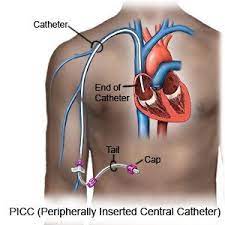PICC Clinic
Contact NowDR. Girish Badarkhe - PICC Specialist Doctor in nashik
A PICC clinic, or Peripherally Inserted Central Catheter clinic, is a specialized medical facility or unit where healthcare professionals insert, manage, and care for PICC lines. A PICC line is a long, thin tube that is inserted through a vein in the arm and threaded through to a larger vein near the heart. It is used to provide intravenous (IV) access for an extended period, often weeks to months, and is typically more comfortable and less invasive than other types of central venous access.
Here are some key functions and activities typically associated with a PICC clinic:
- Insertion: PICC lines are usually inserted in the clinic. A trained healthcare provider, often a nurse or specially trained technician, uses ultrasound or X-ray guidance to place the catheter into a peripheral vein in the arm.
- Care and Maintenance: The clinic staff is responsible for the ongoing care and maintenance of the PICC line. This includes dressing changes, flushing with saline or heparin to prevent clotting, and monitoring for signs of infection or complications.
- Education: Patients and their caregivers are often provided with education on how to care for the PICC line at home, including proper hygiene and how to flush it when necessary.
- Access for Medications: PICC lines are used for a variety of purposes, including the administration of medications, fluids, and parenteral nutrition. The clinic may coordinate with other healthcare providers to ensure that the PICC line is used effectively for these purposes.
- Removal: When the PICC line is no longer needed, it is removed in the clinic. This is typically a straightforward procedure.
- Monitoring and Troubleshooting: The clinic may monitor patients for any signs of complications, such as infection or blockages, and provide troubleshooting or intervention as needed.

PICC lines are often used for patients who require long-term intravenous therapy, such as chemotherapy, antibiotic treatment, or nutritional support. They offer a more stable and reliable means of administering medications and fluids over an extended period compared to traditional IV catheters.
 Dr. Girish Badarkhe
Dr. Girish Badarkhe